高中英语人教版:必修一+非谓语动词语法讲义+Word版
高一英语讲义-非谓语动词讲义

高考英语非谓语动词定义:在句中充当谓语以外的各种句子成分的动词形式,叫做非谓语动词。
非谓语动词也是动词的一种,他们有着谓语动词的其他特点,可以充当宾语、定语、主语、状语、补语等一、非谓语动词基本形式1. 动词不定式:to do 否定形式:not to do2. 动名词:doing 否定形式:not doing现在分词:doing not doing1. 分词过去分词:done not done二、非谓语动词的时态语态变化1.* 现在分词表主动和进行,过去分词表被动和完成。
三、非谓语动词的句法功能(1)二者作主语的差别:动名词作主语多指抽象的、概念性的动作,可以是多次的、经常性的行为;不定式作主语多表示具体的动作,尤指是某一次的动作。
EG.Playing with fire is dangerous. 玩火危险。
(泛指玩火)To play with fire will be dangerous. 玩火会发生危险。
(指一次具体的动作)(2)下列句型常用动名词作主语no use/goodnot any use/good It is/was +of little use/good+ doing sthworthEG.It is worth making an appointment before you go. 去之前预约一下是值得的。
(3)下列句型中常用不定式作主语It + be + 名词+ to do sth.It takes sb. + some time + to do sth.It + be + difficult/easy/hard/important/impossible/necessary ⋯+ for sb. to do sth.④ It + be + careless/clever/good/foolish/honest/kind/lazy/silly/wise ⋯+ of sb. to do sth.EG.It is difficult for us to finish writing the composition in an hour. 我们难以在一小时内完成这篇作文。
非谓语动词讲义

非谓语动词1.非谓语动词除去不能做谓语之外,其他所有成分都可以做。
[思维导图]2.非谓语动词首先是一种动词形式,其次这种动词形式不能做谓语。
非谓语动词除去不能做谓语之外,其他所有成分都可以做。
3.非谓语动词的逻辑主语一般式句子的主语。
4.(1)若提示词为动词,句中没有别的谓语动词,或者虽然已有谓语动词,但需填的动词与之是并列关系时,就该填谓语动词,此时要考虑时态、语态和主谓一致,有时还需考虑虚拟语气。
(2)若提示词为动词,句中已有谓语动词,又不是并列谓语时,就该填非谓语动词,就要确定是v.-ing形式,v.-ed形式,还是不定式。
一般来说,v.-ing 形式表示主动、进行;v.-ed形式表示被动、完成;不定式表示尚未发生的动作。
命题点一动词不定式不定式由“to+动词原形”构成,其否定形式是“not to+动词原形”。
不定式可以加宾语或状语构成不定式短语,它没有人称和数的变化,但有时态和语态的变化。
(一)不定式的用法1.作主语(1)不定式短语作主语时,往往放在谓语之后,用it作形式主语。
To see is to believe.眼见为实。
It is right to give up smoking.戒烟是正确的。
(2)在“It is/was+adj.+for/of sb. to do sth.”结构中,若形容词侧重于评价人物的特性、特征,则构成不定式复合结构的介词应用of,此时形容词常为kind, nice, foolish等词,且sb.与形容词之间可构成逻辑上的系表关系;若形容词侧重于描写不定式动作的特征、特点,则构成不定式复合结构的介词应用for。
It is generous of him to contribute so much.他捐献了这么多真是太慷慨了。
It was important for us to live a low-carbon life.过一种低碳生活对我们来说很重要。
2.作宾语(1)下列动词只能用不定式作宾语,请牢记下面的口诀:我们一致同意在校门口见面。
高一英语语法知识—非谓语动词人教版知识精讲
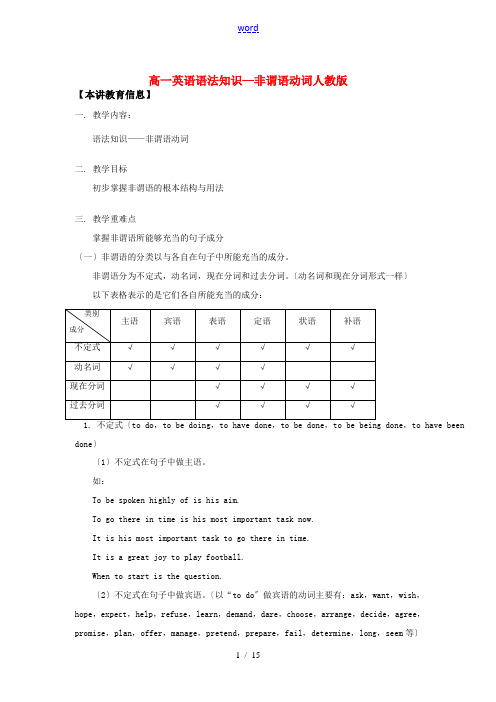
高一英语语法知识—非谓语动词人教版【本讲教育信息】一. 教学内容:语法知识——非谓语动词二. 教学目标初步掌握非谓语的根本结构与用法三. 教学重难点掌握非谓语所能够充当的句子成分〔一〕非谓语的分类以与各自在句子中所能充当的成分。
非谓语分为不定式,动名词,现在分词和过去分词。
〔动名词和现在分词形式一样〕以下表格表示的是它们各自所能充当的成分:,to have been done〕〔1〕不定式在句子中做主语。
如:To be spoken highly of is his aim.To go there in time is his most important task now.It is his most important task to go there in time.It is a great joy to play football.When to start is the question.〔2〕不定式在句子中做宾语。
〔以“to do〞做宾语的动词主要有:ask,want,wish,hope,expect,help,refuse,learn,demand,dare,choose,arrange,decide,agree,promise,plan,offer,manage,pretend,prepare,fail,determine,long,seem等〕如:They pretended to have finished their work.He had planned to finish it in time.They thought it necessary to go to church every weekend.We find it good to have a walk every day.They don’t now where to go.〔3〕不定式在句子中做表语。
如:His dream is to be taught by that famous professor.The only thing he wants to do now is to study hard.His aim is to get the first place in the game.The question is which one to choose.〔4〕不定式在句子中做状语。
【2019最新】高中英语语法-高中英语语法讲义1-推荐word版 (2页)
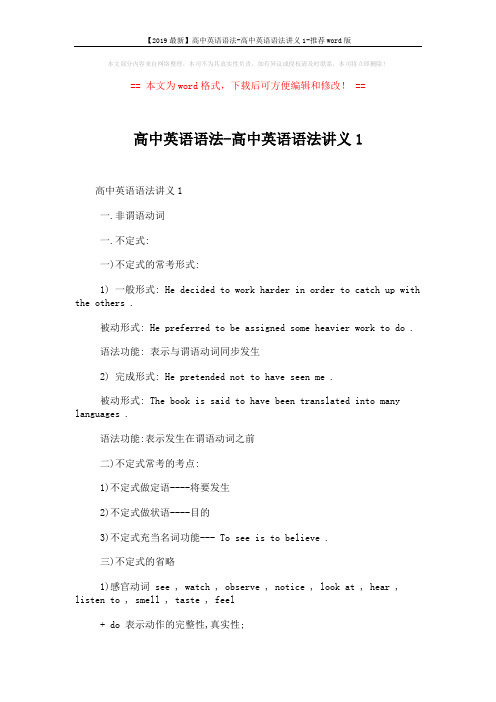
【2019最新】高中英语语法-高中英语语法讲义1-推荐word版
本文部分内容来自网络整理,本司不为其真实性负责,如有异议或侵权请及时联系,本司将立即删除!
== 本文为word格式,下载后可方便编辑和修改! ==
高中英语语法-高中英语语法讲义1
高中英语语法讲义1
一.非谓语动词
一.不定式:
一)不定式的常考形式:
1) 一般形式: He decided to work harder in order to catch up with the others .
被动形式: He preferred to be assigned some heavier work to do .
语法功能: 表示与谓语动词同步发生
2) 完成形式: He pretended not to have seen me .
被动形式: The book is said to have been translated into many languages .
语法功能:表示发生在谓语动词之前
二)不定式常考的考点:
1)不定式做定语----将要发生
2)不定式做状语----目的
3)不定式充当名词功能--- To see is to believe .
三)不定式的省略
1)感官动词 see , watch , observe , notice , look at , hear , listen to , smell , taste , feel
+ do 表示动作的完整性,真实性;。
高中英语人教版:必修一+非谓语动词语法讲义+Word版
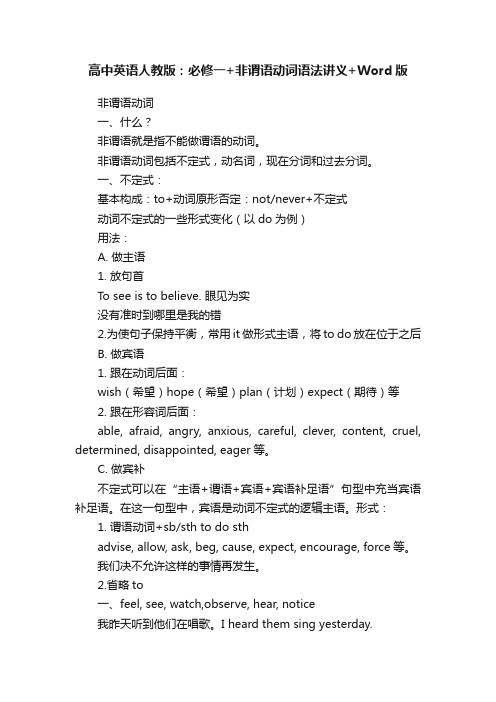
高中英语人教版:必修一+非谓语动词语法讲义+Word版非谓语动词一、什么?非谓语就是指不能做谓语的动词。
非谓语动词包括不定式,动名词,现在分词和过去分词。
一、不定式:基本构成:to+动词原形否定:not/never+不定式动词不定式的一些形式变化(以do为例)用法:A. 做主语1. 放句首To see is to believe. 眼见为实没有准时到哪里是我的错2.为使句子保持平衡,常用it做形式主语,将to do放在位于之后B. 做宾语1. 跟在动词后面:wish(希望)hope(希望)plan(计划)expect(期待)等2. 跟在形容词后面:able, afraid, angry, anxious, careful, clever, content, cruel, determined, disappointed, eager等。
C. 做宾补不定式可以在“主语+谓语+宾语+宾语补足语”句型中充当宾语补足语。
在这一句型中,宾语是动词不定式的逻辑主语。
形式:1. 谓语动词+sb/sth to do sthadvise, allow, ask, beg, cause, expect, encourage, force等。
我们决不允许这样的事情再发生。
2.省略to一、feel, see, watch,observe, hear, notice我昨天听到他们在唱歌。
I heard them sing yesterday.二、make, let, have他希望做什么就让他做好了。
D. 做状语不定式作状语可以表示行为的目的、结果、原因、条件等。
1 表示目的我省钱为了买一台电脑。
I’m saving money to buy a computer.2 表示结果My grandmother lived to see the liberation of China.(Only to do sth) 表示出乎意料He got to the station only to find the train had gone.3 表示原因I am very glad to see you.4 表示条件To have a talk with him, you would like him.5:表程度He was too excited to say a work.He is old enough to go to schoolE. 做表语他的愿望是做一个老师。
(完整word版)非谓语动词讲解

非谓语动词【知识要点】定义:在英语中,不作句子谓语,而具有除谓语外其他语法功能的动词,叫做非谓语动词。
分类:非谓语动词有动词不定式(the Infinitive);动名词(the Gerund);现在分词(the Present Participle);过去分词(the Past Participle)。
无论它们在句中作什么成分,他们都保持着自己本身的属性特点。
动词不定式:表将来、具体某一次,常在句中可以作: 主语,宾语,定语,状语,补语,表语;动名词:具有名词功能,常在句中可以作:主语,宾语,表语;作定语时表功能;现在分词:表主动和正在进行, 常在句中可以作: 定语,状语,表语,宾补;过去分词:表被动和已完成,常在句中可以作: 定语,状语,补语。
一、动词不定式不定式由“to+动词原形”构成,其否定形式是“not to+动词原形”。
不定式可以带宾语或状语构成不定式短语,没有人称和数的变化,但有时态和语态的变化。
不定式可作主语、宾语、状语、表语、定语和补语,但不能单独作谓语。
2. 不定式的句法功能1)作主语:To finish the work in ten minutes is very hard.在十分钟内完成这项工作很难。
动词不定式短语作主语时,常用it作形式主语,例如上面一句可用如下形式:It is very hard to finish the work in ten minutes.2)作表语:Her job is to clean the hall.她的工作就是打扫大厅。
3)作宾语:V.+ to do sth.常与不定式作宾语连用的动词有:want, hope, wish, offer, fail, plan, learn, pretend, refuse, manage, help, agree, promise, prefer,afford,ask,decide,expect,intend,等。
(完整word版)高中英语专题非谓语动词精讲
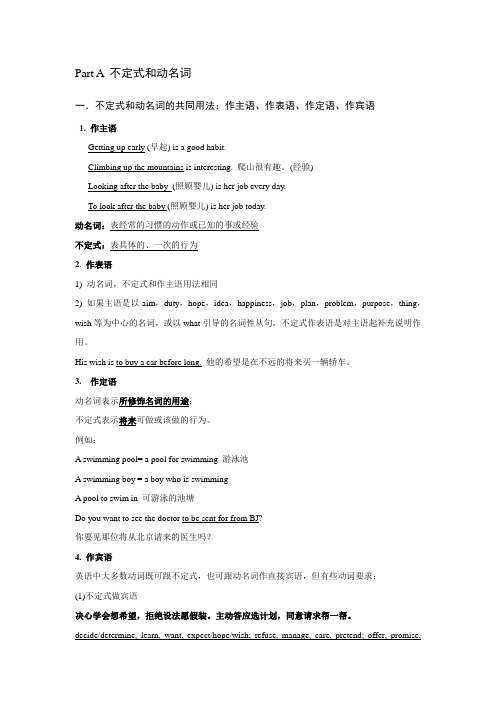
Part A 不定式和动名词一.不定式和动名词的共同用法:作主语、作表语、作定语、作宾语1. 作主语Getting up early (早起) is a good habit.Climbing up the mountains is interesting. 爬山很有趣。
(经验)Looking after the baby_(照顾婴儿) is her job every day.To look after the baby (照顾婴儿) is her job today.动名词:表经常的习惯的动作或已知的事或经验不定式:表具体的、一次的行为2. 作表语1) 动名词,不定式和作主语用法相同2) 如果主语是以aim,duty,hope,idea,happiness,job,plan,problem,purpose,thing,wish等为中心的名词,或以what引导的名词性从句,不定式作表语是对主语起补充说明作用。
His wish is to buy a car before long.他的希望是在不远的将来买一辆轿车。
3. 作定语动名词表示所修饰名词的用途;不定式表示将来可做或该做的行为。
例如:A swimming pool= a pool for swimming 游泳池A swimming boy = a boy who is swimmingA pool to swim in 可游泳的池塘Do you want to see the doctor to be sent for from BJ?你要见那位将从北京请来的医生吗?4. 作宾语英语中大多数动词既可跟不定式,也可跟动名词作直接宾语,但有些动词要求:(1)不定式做宾语决心学会想希望,拒绝设法愿假装。
主动答应选计划,同意请求帮一帮。
decide/determine, learn, want, expect/hope/wish; refuse, manage, care, pretend; offer, promise,choose, plan; agree, ask/beg, help此外:seem, attempt, fail, happen, afford, strive, make up one’s mind to, be determined to, would/should like/love to注意:不定式作介词but, except(除了)的宾语。
高中英语人教必修第一册 Unit 1 grammar 非谓语动词作主语和宾语 课件

1. It’s no use/no good/useless doing sth. 2. It’s a waste of time/money doing sth. 3. There is no point/ no sense doing sth.
8
即时练习
谓语动词和非谓语动词的区别
6
doing 固定句式
1. It’s no use/no good/useless doing sth. 2. It’s a waste of time/money doing sth. 3. There is no point/ no sense doing sth.
It is no use regreting. It’s a waste of time playing game. There is no point studying without thinking.
非谓语动词
---主语和宾语
1
2
非谓语动词作主语
动词不定式
具体的、特定的ห้องสมุดไป่ตู้为 ----特指
V-ing形式(动名词)
经常性的、习惯性的动作 ----泛指
3
动词不定式作主语
1.To say is easy, but to do is hard. 2.To hear your voice is so nice.
5. It is important
me to attend the math competition.
非谓语与主句谓语比较发生时间的先后 6. There is no-s-e-n-s确e 定语态 (wait) here.
10
11
非谓语动词作宾语
非谓语动词讲义

非谓语动词一.非谓语动词:动词的某种特殊形式,在句子中做除谓语外的其他成分。
分类:动词不定式,动名词,现在分词,过去分词。
二.动词不定式:构成:to do。
否定形式:not to do .发生。
eg: I plan to live a busy life in high school.She seems to be unhappy.The computer needs to be repaired.完成式:不定式的动作发生在谓语动词的动作之前。
eg: I am sorry to have kept you waiting so long.The house seems to have been broken into.进行式:不定式的动作与谓语动词的动作同时发生。
eg: She pretended to be reading when her mother came in.He happened to be searching my bag when I came in.2.句法功能:(1)做主语:To see is to believe. 眼见为实/百闻不如一见。
It is adj for/of sb to do sth. 对某人来说,做某事是It is impossible for me to live alone in Beijing.It is not easy to find your way around the town.(2)做宾语:afford, agree, aim, bear, begin, bother, care, choose, continue, decide, demand, desire, determine, expect, fail, forget, hate, help, hope, intend, learn, manage, mean, need, offer, plan, pretend, refuse, remember, want, wish, promise, happeneg: She has determined to be a leader.注: 如果不定式做宾语,且后面有宾补时,把不定式后置,用it来做形式宾语。
人教版高中英语必修一高一英语非谓语动词及其用法

d. The man is too easy to get angry. 这人太容易生气了.
e. only too…to I’m only too delighted to accept your invitation.
1. I appreciate hearing from you again.
2. avoid being infected by diseases
3. He doesn’t feel like eating anything.
4. I don’t think it any good / use complaining about it . 常用doing作宾语的有
1. The bus stopped to pick up passengers. 2. He spoke slowly and clearly to make himself understood. 3. He set out early in order to / so as to catch the first bus.
6. I have no choice butto wait / can do nothing butwait.
(but = except 前面有do,其后的不定式省“to”)
7. He would ratherdie than give in.
8. Who would you ratherhave go, Mary or me?
object to
can’t stand / bear
be opposed to
on the way to 即将做某事
高一英语讲义-非谓语动词 讲义

高考英语非谓语动词定义:在句中充当谓语以外的各种句子成分的动词形式,叫做非谓语动词。
非谓语动词也是动词的一种,他们有着谓语动词的其他特点,可以充当宾语、定语、主语、状语、补语等 一、非谓语动词基本形式1. 动词不定式:to do否定形式:not to do 2. 动名词:doing 否定形式:not doing 现在分词:doing not doing 1. 分词过去分词:done not done 二、非谓语动词的时态语态变化 1. 动词不定式 2. 动名词 3. 分词* 现在分词表主动和进行,过去分词表被动和完成。
三、非谓语动词的句法功能1. 非谓语动词(不定式、动名词)作主语 (1)二者作主语的差别:动名词作主语多指抽象的、概念性的动作,可以是多次的、经常性的行为; 不定式作主语多表示具体的动作,尤指是某一次的动作。
EG.Playing with fire is dangerous. 玩火危险。
(泛指玩火)To play with fire will be dangerous. 玩火会发生危险。
(指一次具体的动作) (2)下列句型常用动名词作主语 EG.It is worth making an appointment before you go. 去之前预约一下是值得的。
(3)下列句型中常用不定式作主语 It + be + 名词 + to do sth.② It takes sb. + some time + to do sth.③ It + be + difficult/easy/hard/important/impossible/necessary… + for sb. to do sth.④It + be + careless/clever/good/foolish/honest/kind/lazy/silly/wise… + of sb. to do sth.EG.It is difficult for us to finish writing the composition in an hour. 我们难以在一小时内完成这篇作文。
高中英语非谓语动词经典用法讲解(精编文档).doc

【最新整理,下载后即可编辑】高中英语非谓语动词经典用法讲解★非谓语动词(doing/to do)作主语非谓语动词能用作主语的只有不定式和动名词,它们在这一用法上略有区别:1. 表示泛指或经常性的事情用动名词作主语;表示特指,个别的,具体的动作或表示将来的意思时,只能用不定式作主语。
① Swimming is interesting.② To swim with my good friend is interesting.2. 1)不定式短语和动名词短语作主语时常用形式主语it引导。
It is not easy to master a foreign language. 掌握一门外语不容易。
2)在it is no good/ use / help/ point/ sense …,it is a waste of time doing... 和there is no … 等句式中,一般用动名词,不可用不定式代替。
① There is no use crying over spilt milk. 覆水难收。
② It is no good writing to him; he never answers letters.Is there any good trying to explain? 解释会有用吗3)不定式的复合结构常用“it + be + adj. + for/of sb. +不定式”的句式,其中不定式是真正的主语。
① It is necessary for us to do some more practice. 我们必须多做一些练习。
② It is really kind of you to say so. 你这样说真是太好了。
若主语和表语都是非谓语动词,应保持形式上的一致。
Seeing is believing. / To see is to believe.★不定式、动名词作宾语用法要点一、下面动词只能用不定式作宾语,Decide / determine, learn, want, expect / hope / wish, refuse, manage, care, pretend, offer, promise, choose, plan, agree, ask / beg, help,afford, 例如:① She pretended not to see me when I passed by.② We agreed to meet here but so far she hasn’t turned up yet.二、下列动词只能用动名词作宾语,请牢记下列小诗:consider / suggest / advise, look forward to, excuse, pardon, admit, delay/ put off, fancy, avoid, miss, keep / keep on, practise, deny, finish, enjoy / appreciate, can’t help, mind, allow / permit, escape, imagine, forbid, risk此外be used to, look forward to, lead to, devote to, stick to, object to, get down to, pay attention to, can’t stand (无法忍受), give up, feel like, insist on, put off, thank you for, apologize for, be busy (in), have difficulty / trouble (in), have a good / wonderful /hard time /difficulty (in)等动词词组也要用动名词作宾语。
高一英语初步掌握非谓语的基本结构及用法人教版知识精讲

高一英语初步掌握非谓语的基本构造及用法人教版【本讲教育信息】一.教课内容:初步掌握非谓语的基本构造及用法二.教课重难点掌握非谓语所能够充任的句子成分(一)非谓语的分类以及各自在句子中所能充任的成分。
非谓语分为不定式,动名词,此刻分词和过去分词。
(动名词和此刻分词形式相同)以下表格表示的是它们各自所能充任的成分:成分主语宾语表语定语状语补语类型不定式√√√√√√动名词√√√√此刻分词√√√√过去分词√√√√此刻分词:(doing , having done,being done ,having been done )1.此刻分词在句子中做表语。
(即进行时态)如:He is playing football on the playground.I was studying English from 1991 to 1999.2.此刻分词在句子中做定语。
如:Do you know the man speaking to my teacher?I saw a sleeping cat when I entered the room.3.此刻分词在句子中做状语。
此刻分词在句子中做状语表示在主句动作发生的同时,主语又发生的事情。
如:The boy sat there thinking about his plan.The man looked at his broken car, wondering how much it will cost to get itrepaired.Having finished his breakfast, Tom went to school.Being highly praised, he thought of another great adventure.注意:非谓语做状语的时候,其逻辑主语必定是主句的主语,如:Having examined him, the doctor told him OK.Having been examined, he was told OK.特例:不需与主句主语一致的此刻分词状语有: judging from/by , generallyspeaking , considering ,talking of ,supposing ,beginning 等)4.在句子中做宾补。
高一须掌握的非谓语动词知识点(完美版).docx
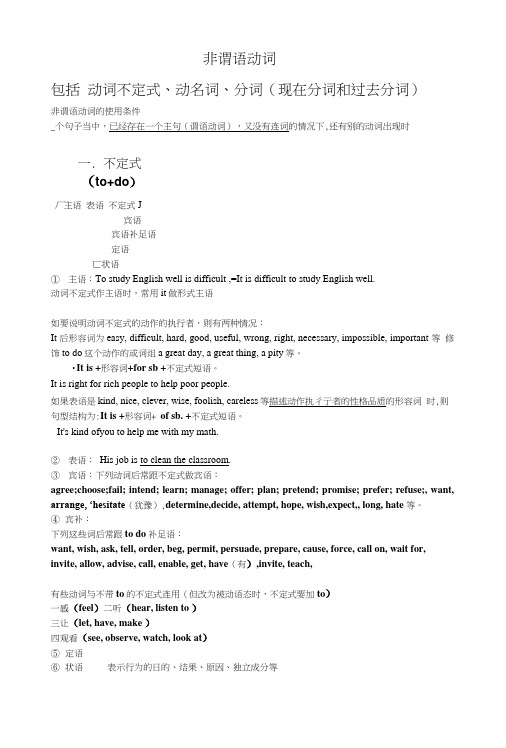
非谓语动词包括动词不定式、动名词、分词(现在分词和过去分词)非谓语动词的使用条件_个句子当中,已经存在一个主句(谓语动词),又没有连词的情况下,还有别的动词出现时一. 不定式(to+do)厂主语表语不定式J宾语宾语补足语定语匸状语①主语:To study English well is difficult ,=It is difficult to study English well.动词不定式作主语时,常用it做形式主语如要说明动词不定式的动作的执行者,则有两种情况:It 后形容词为easy, difficult, hard, good, useful, wrong, right, necessary, impossible, important 等修饰to do这个动作的或词组a great day, a great thing, a pity等。
・It is +形容词+for sb +不定式短语。
It is right for rich people to help poor people.如果表语是kind, nice, clever, wise, foolish, careless等描述动作执彳亍者的性格品质的形容词时,则句型结构为:It is +形容词+ of sb. +不定式短语。
It's kind ofyou to help me with my math.②表语:His job is to clean the classroom.③宾语:下列动词后常跟不定式做宾语:agree;choose;fail; intend; learn; manage; offer; plan; pretend; promise; prefer; refuse;, want, arrange, ‘hesitate(犹豫),determine,decide, attempt, hope, wish,expect,, long, hate 等。
- 1、下载文档前请自行甄别文档内容的完整性,平台不提供额外的编辑、内容补充、找答案等附加服务。
- 2、"仅部分预览"的文档,不可在线预览部分如存在完整性等问题,可反馈申请退款(可完整预览的文档不适用该条件!)。
- 3、如文档侵犯您的权益,请联系客服反馈,我们会尽快为您处理(人工客服工作时间:9:00-18:30)。
非谓语动词一、什么?非谓语就是指不能做谓语的动词。
非谓语动词包括不定式,动名词,现在分词和过去分词。
一、不定式:基本构成:to+动词原形否定:not/never+不定式动词不定式的一些形式变化(以do为例)用法:A. 做主语1. 放句首To see is to believe. 眼见为实没有准时到哪里是我的错2.为使句子保持平衡,常用it做形式主语,将to do放在位于之后B. 做宾语1. 跟在动词后面:wish(希望)hope(希望)plan(计划)expect(期待)等2. 跟在形容词后面:able, afraid, angry, anxious, careful, clever, content, cruel, determined, disappointed, eager等。
C. 做宾补不定式可以在“主语+谓语+宾语+宾语补足语”句型中充当宾语补足语。
在这一句型中,宾语是动词不定式的逻辑主语。
形式:1. 谓语动词+sb/sth to do sthadvise, allow, ask, beg, cause, expect, encourage, force等。
我们决不允许这样的事情再发生。
2.省略to一、feel, see, watch,observe, hear, notice我昨天听到他们在唱歌。
I heard them sing yesterday.二、make, let, have他希望做什么就让他做好了。
D. 做状语不定式作状语可以表示行为的目的、结果、原因、条件等。
1 表示目的我省钱为了买一台电脑。
I’m saving money to buy a computer.2 表示结果My grandmother lived to see the liberation of China.(Only to do sth) 表示出乎意料He got to the station only to find the train had gone.3 表示原因I am very glad to see you.4 表示条件To have a talk with him, you would like him.5:表程度He was too excited to say a work.He is old enough to go to schoolE. 做表语他的愿望是做一个老师。
F:做定语1: 作定语的不定式如果是不及物动词,或者不定式所修饰的名词或代词是不定式动作的地点,工具等,不定式后面需要相应的介词。
The Browns have a comfortable room to live in但是,不定式所修饰的名词如果的time, place或way时,不定式后面的介词习惯省去。
He had no place to live (in)2:当作定语的不定式所修饰的名词或代词是不定式动作的承受者,不定式既可以是主动语态,也可用被动语态,但是含义略有不同。
Have you got anything to send?Have you got anything to be sent?二、动词ing构成:V-ing 否定:not V-ing用法:A.做主语Seeing is believing.B.做宾语a. 只能-ing做宾语的b. -ing 和不定式都可以做宾语的动词★有些动词,如hate, love, prefer等,后面接动词-ing形式或不定式区别不是很大。
They prefer spending/to spend their summer vacation in Dalian.★有些动词或词组后可带动名词或不定式作宾语,但意义上有所不同。
1. forget forget to do forget doing典型例题—— The light in the office is still on. —— Oh, I forgot ___.A. turning it offB. turn it offC. to turn it offD. having turned it off2 stop stop to do stop doing典型例题She reached the top of the hill and stopped ___ on a big rock by the side of the path.A. to have restedB. restingC. to restD. rest3 remember/forget/regret remember to do remember doing记着放学后去趟邮局。
你不记得以前见过那个人吗?典型例题---You were brave enough to raise objections at the meeting.---Well, now I regret ___ that.A.to doB. to be doingC.to have doneD.having done5.try try to do try doing你可要多加小心。
我试着种果木花卉,但未成功。
6.go on go on to do go on doing做完数学后,他接着去做物理7 mean to doing/to do mean to do mean doingI mean to go, but my father would not allow me to.To raise wage means increasing purchasing power.8 begin(start) doing/to do1. 谈及一项长期活动或开始一种习惯时,使用doing.你几岁时开始弹钢琴?how old were you when you first started playing the piano.2. begin,start用进行时时,后面动词用不定式to do我开始生起气来。
I was beginning to get angry.3. 在begin,start 后接know, understand, realize这类动词时,常用不定式to do。
我开始明白真相。
I begin to understand the truth9: can’t help (to) do sth 不能帮助做某事Can’t help doing sth 情不自禁做某事c.介词后面加动词-ingJason aims at becoming an astronaut.Please excuse me for being late.We like his way of teaching English.C. 做宾补动词-ing形式可以在see, hear, notice, watch, observe, find等表示感官和心理状态的动词后面作宾语补足语,和一个名词或代词一起构成复合宾语。
We heard the children shouting upstairs.I noticed a man running out of the bank when I got off the car.D. 做状语动词-ing形式可以作状语,修饰动词,在句中表示时间、原因、结果、条件、让步、行为方式或伴随情况等。
动词-ing形式作时间、原因、条件、让步状语时多位于句首;作结果、伴随情况状语时常位于句末。
1表示时间。
Seeing those pictures, she remembered her childhood.2表示原因Not knowing his address, I can't send this book to him.Being ill, he didn't go to school yesterday.3表示结果。
His father died, leaving him a lot of money.4表示条件。
Going straight down the road, you will find the department store.5表示让步。
Knowing all this, they made me pay for the damage.6表示行为方式、伴随情况或补充说明。
He lay on the grass, staring at the sky for a long time.E. 做表语Seeing is believing.F. 做定语(动名词)①说明被修饰名词的用途和性能。
a reading room 阅览室running shoes 跑鞋 a working method 工作方法②表示所修饰的人或物的动作或状态,在意思上接近一个定语从句,可以表示正在进行的动作,也可表示经常性动作或当时的状态。
developing countries 发展中国家an ordinary-looking house 看起来很普通的房子三、动词-ed 构成:动词-ed 否定:not/never +动词-ed动词-ed形式只有一种形式,即传统语法中的过去分词。
绝大部分的动词-ed形式由动词原形扣-ed构成,也有一些动词-ed形式是不规则的。
用法:A. 做表语:动词-ed形式在系动词后作表语,说明主语的状态。
The students are fully prepared.When we got there, the shop was closed.B. 做宾补1在感觉动词see, hear, feel, notice, watch, find等后作宾语补足语。
I heard the Ninth Symphony played last night.2在使役动词get, have, make, leave, keep等后作宾语补足语。
①动词-ed形式作get的宾语补足语。
Doris got her bad tooth pulled out in the hospital.②动词-ed形式作make的宾语补足语。
He raised his voice in order to make himself heard.③动词-ed形式作keep或leave的宾语补足语。
They all went home, leaving all the work undone.The detective and his assistant kept themselves locked in the room all night.C. 做定语动词-ed形式作定语修饰名词分为前置和后置两类。
